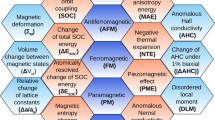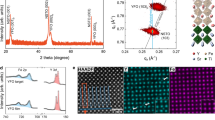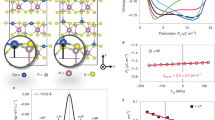Abstract
Complex insulating perovskite alloys are of considerable technological interest because of their large dielectric and piezoelectric responses. Examples of such alloys include (Ba1-xSrx)TiO3, which has emerged as a leading candidate dielectric material for the memory-cell capacitors in dynamic random access memories1; and Pb(Zr1-xTix)O3 (PZT), which is widely used in transducers and actuators2. The rich variety of structural phases that these alloys can exhibit, and the challenge of relating their anomalous properties to the microscopic structure, make them attractive from a fundamental point of view. Theoretical investigations of modifications to the atomic ordering of these alloys suggest the existence of further unexpected structural properties3 and hold promise for the development of new functional materials with improved electromechanical properties. Here we report ab initio calculations that show that a certain class of atomic rearrangement should lead simultaneously to large electromechanical responses and to unusual structural phases in a given class of perovskite alloys. Our simulations also reveal the microscopic mechanism responsible for these anomalies.
This is a preview of subscription content, access via your institution
Access options
Subscribe to this journal
Receive 51 print issues and online access
$199.00 per year
only $3.90 per issue
Buy this article
- Purchase on Springer Link
- Instant access to full article PDF
Prices may be subject to local taxes which are calculated during checkout



Similar content being viewed by others
References
Abe, K. & Komatsu, S. Ferroelectric properties in epitaxially grown BaxSr1-xTiO3 thin films. J. Appl. Phys. 77, 6461–6465 (1995).
Uchino, K. Piezoelectric Actuators and Ultrasonic Motors (Kluwer Academic, Boston, 1996).
Sai, N., Meyer, B. & Vanderbilt, D. Compositional inversion symmetry breaking in ferroelectric perovskites. Phys. Rev. Lett. 84, 5636–5639 (2000).
Park, S.-E. & Shrout, T. R. Ultrahigh strain and piezoelectric behavior in relaxor based ferroelectric single crystal. J. Appl. Phys. 82, 1804–1811 (1997).
Service, R. F. Shape-changing crystals get shiftier. Science 275, 1878 (1997).
Noheda, B. et al. A monoclinic ferroelectric phase in the Pb(Zr1-xTix)O3 solid solution. Appl. Phys. Lett. 74, 2059–2061 (1999).
Bellaiche, L., García, A. & Vanderbilt, D. Finite-temperature properties of Pb(Zr1-xTix)O3 alloys from first principles. Phys. Rev. Lett. 84, 5427–5430 (2000).
Hemphill, R., Bellaiche, L., García, A. & Vanderbilt, D. Finite-temperature properties of disordered and ordered Pb(Sc0.5Nb0.5)O3 alloys. Appl. Phys. Lett. 77, 3642–3644 (2000).
Hohenberg, P. & Kohn, W. Inhomogeneous electron gas. Phys. Rev. 136, B864–871 (1964).
Kohn, W. & Sham, L. J. Self-consistent equations including exchange and correlation effects. Phys. Rev. 140, A1133–1138 (1965).
Vanderbilt, D. Soft self-consistent pseudopotentials in a generalized eigenvalue formalism. Phys. Rev. B 41, 7892–7895 (1990).
Bellaiche, L. & Vanderbilt, D. Virtual crystal approximation revisited: Application to dielectric and piezoelectric properties of perovskites. Phys. Rev. B 61, 7877–7882 (2000).
Chu, F., Reaney, I. M. & Setter, N. Spontaneous (zero-field) relaxor-to-ferroelectric-phase transition in disordered Pb(Sc1/2Nb1/2)O3. J. Appl. Phys. 77, 1671–1676 (1995).
Vanderbilt, D. & Cohen, M. H. Monoclinic and triclinic phases in higher-order Devonshire theory. Phys. Rev. B 63, 094108 (2001).
Ramer, N. J. & Rappe, A. M. Application of a new virtual crystal approach for the study of disordered perovskites. J. Phys. Chem. Solids 61, 315–320 (2000).
Fu, H. & Cohen, R. E. Polarization rotation mechanism for ultrahigh electromechanical response in single crystal piezoelectrics. Nature 403, 281–283 (2000).
Brazier, M., McElfresh, M. & Mansour, S. Unconventional hysteresis behavior in compositionally graded Pb(Zr,Ti)O3 thin films. Appl. Phys. Lett. 72, 1121–1123 (1998).
Acknowledgements
This work was supported by the National Science Foundation, the Office of Naval Research and the Arkansas Science and Technology Authority. We thank D. Vanderbilt and A. García for discussions.
Author information
Authors and Affiliations
Corresponding author
Rights and permissions
About this article
Cite this article
George, A., Íñiguez, J. & Bellaiche, L. Anomalous properties in ferroelectrics induced by atomic ordering. Nature 413, 54–57 (2001). https://doi.org/10.1038/35092530
Received:
Accepted:
Issue Date:
DOI: https://doi.org/10.1038/35092530
This article is cited by
-
Extended planar defects of oxygen vacancies in ferroelectric \(\hbox {BaTiO}_3\) and impact on ferroelectricity
Scientific Reports (2023)
-
Study on Defects in Fe-Doped SrTiO3 by Positron Annihilation Lifetime Spectroscopy
Wuhan University Journal of Natural Sciences (2019)
-
Persistence of strong and switchable ferroelectricity despite vacancies
Scientific Reports (2017)
-
Massive band gap variation in layered oxides through cation ordering
Nature Communications (2015)
-
Effect of milling on properties and consolidation of AlN by high-frequency induction heated sintering
Electronic Materials Letters (2014)
Comments
By submitting a comment you agree to abide by our Terms and Community Guidelines. If you find something abusive or that does not comply with our terms or guidelines please flag it as inappropriate.



